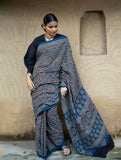| AUTHENTIC CRAFT. CREATED IN INDIA.
Handwoven Sambhalpuri Ikat Cotton Saree - Brown & Deep Green
| AUTHENTIC CRAFT. CREATED IN INDIA.
Handwoven Sambhalpuri Ikat Cotton Saree - Brown & Deep Green
DBS01C
A beautiful statement in a hand woven Sambhalpuri Ikat cotton saree from Orissa (without blouse piece). A Sambalpuri sari is a traditional handwoven bandha (ikat) sari (locally called "sambalpuri bandha" sadhi or saree) wherein the warp and the weft are tie-dyed before weaving.Sambalpuri sarees typically feature traditional motifs like flowers, animals, and geometric patterns.
Craft StoryAdding product to your cart
Available Offers
- Code: MBK500 | Get upto Rs.500 cashback on min txn of Rs.2999

- Enjoy complimentary shipping on all domestic orders upto Rs.31,999












